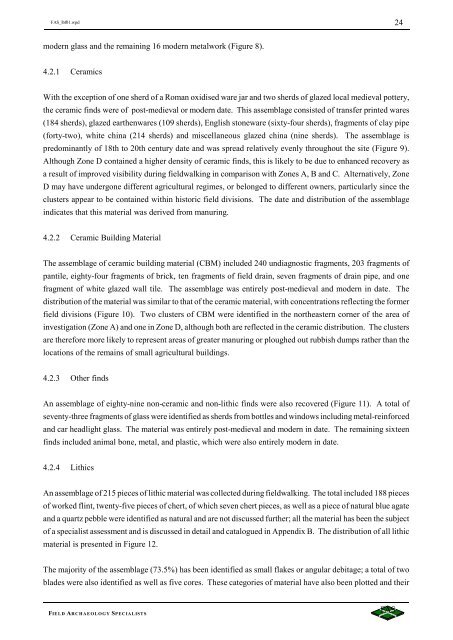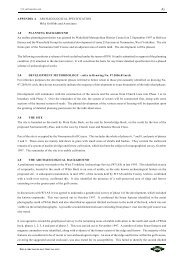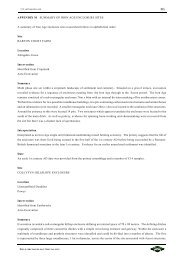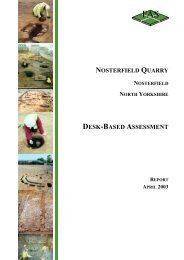ARCHAEOLOGICAL EVALUATION - Mike Griffiths and Associates
ARCHAEOLOGICAL EVALUATION - Mike Griffiths and Associates
ARCHAEOLOGICAL EVALUATION - Mike Griffiths and Associates
Create successful ePaper yourself
Turn your PDF publications into a flip-book with our unique Google optimized e-Paper software.
FAS_lbf01.wpd 24<br />
modern glass <strong>and</strong> the remaining 16 modern metalwork (Figure 8).<br />
4.2.1 Ceramics<br />
With the exception of one sherd of a Roman oxidised ware jar <strong>and</strong> two sherds of glazed local medieval pottery,<br />
the ceramic finds were of post-medieval or modern date. This assemblage consisted of transfer printed wares<br />
(184 sherds), glazed earthenwares (109 sherds), English stoneware (sixty-four sherds), fragments of clay pipe<br />
(forty-two), white china (214 sherds) <strong>and</strong> miscellaneous glazed china (nine sherds). The assemblage is<br />
predominantly of 18th to 20th century date <strong>and</strong> was spread relatively evenly throughout the site (Figure 9).<br />
Although Zone D contained a higher density of ceramic finds, this is likely to be due to enhanced recovery as<br />
a result of improved visibility during fieldwalking in comparison with Zones A, B <strong>and</strong> C. Alternatively, Zone<br />
D may have undergone different agricultural regimes, or belonged to different owners, particularly since the<br />
clusters appear to be contained within historic field divisions. The date <strong>and</strong> distribution of the assemblage<br />
indicates that this material was derived from manuring.<br />
4.2.2 Ceramic Building Material<br />
The assemblage of ceramic building material (CBM) included 240 undiagnostic fragments, 203 fragments of<br />
pantile, eighty-four fragments of brick, ten fragments of field drain, seven fragments of drain pipe, <strong>and</strong> one<br />
fragment of white glazed wall tile. The assemblage was entirely post-medieval <strong>and</strong> modern in date. The<br />
distribution of the material was similar to that of the ceramic material, with concentrations reflecting the former<br />
field divisions (Figure 10). Two clusters of CBM were identified in the northeastern corner of the area of<br />
investigation (Zone A) <strong>and</strong> one in Zone D, although both are reflected in the ceramic distribution. The clusters<br />
are therefore more likely to represent areas of greater manuring or ploughed out rubbish dumps rather than the<br />
locations of the remains of small agricultural buildings.<br />
4.2.3 Other finds<br />
An assemblage of eighty-nine non-ceramic <strong>and</strong> non-lithic finds were also recovered (Figure 11). A total of<br />
seventy-three fragments of glass were identified as sherds from bottles <strong>and</strong> windows including metal-reinforced<br />
<strong>and</strong> car headlight glass. The material was entirely post-medieval <strong>and</strong> modern in date. The remaining sixteen<br />
finds included animal bone, metal, <strong>and</strong> plastic, which were also entirely modern in date.<br />
4.2.4 Lithics<br />
An assemblage of 215 pieces of lithic material was collected during fieldwalking. The total included 188 pieces<br />
of worked flint, twenty-five pieces of chert, of which seven chert pieces, as well as a piece of natural blue agate<br />
<strong>and</strong> a quartz pebble were identified as natural <strong>and</strong> are not discussed further; all the material has been the subject<br />
of a specialist assessment <strong>and</strong> is discussed in detail <strong>and</strong> catalogued in Appendix B. The distribution of all lithic<br />
material is presented in Figure 12.<br />
The majority of the assemblage (73.5%) has been identified as small flakes or angular debitage; a total of two<br />
blades were also identified as well as five cores. These categories of material have also been plotted <strong>and</strong> their<br />
FIELD ARCHAEOLOGY SPECIALISTS







